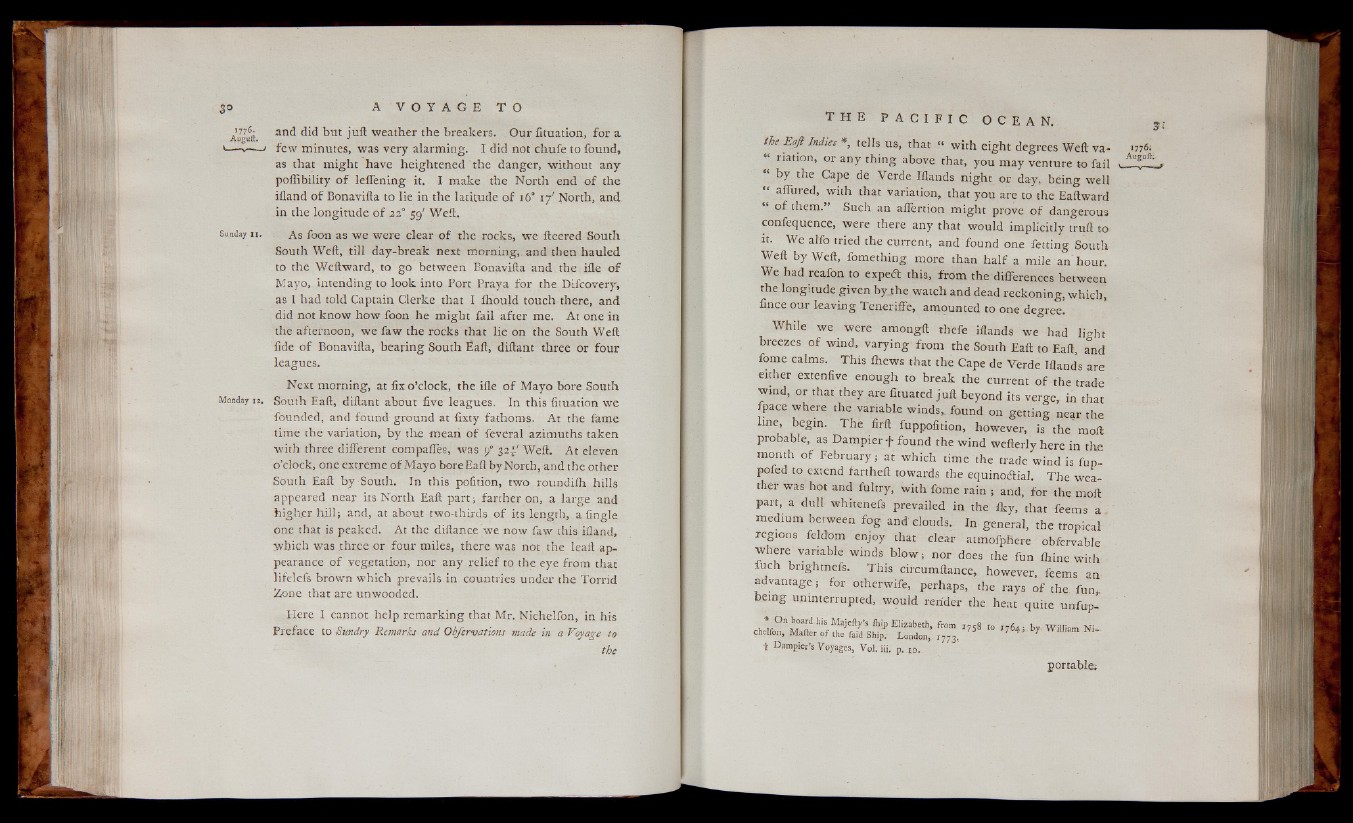
I
W 6: and did "but juft weather the breakers. Our fituation, for a Auguft. . J ’
c—■v— ' few minutes, was very alarming. I did not chufe to found,
as that might have heightened the danger, without any
poffibility of leffening it. I make the North end o f the
ifland of Bonavifta to lie in the latitude of 16“ 17' North, and
in the longitude o f 22° 59' Weil.
Sunday ii. As foon as we were clear of the rocks, we fleered South
South Weft, till day-break next morning, and then hauled
to the Weftward, to go between Bonavifta and the ifle of
Mayo, intending to look into Port Praya for the Difcovery,
as I had told Captain Clerke that I ihould touch there, and
did not know how foon he might fail after me. At one in
the afternoon, we faw the rocks that lie on the South Weft
fide of Bonavifta, bearing South ¿aft, diftant three or four
leagues.
Next morning, at fix o’clock, the ifle o f Mayo bore South
Monday 12. South Eaft, diftant about five leagues. In this fituation we
founded, and found ground at fixty fathoms. At the fame
time the variation, by the mean of feveral azimuths taken
with three different compafies, was </ 324' Weft. At eleven
o’clock, one extreme of Mayo boreEaft by North, and the other
South Eaft by South. In this pofition, two roundifh hills
appeared near its North Eaft part; farther on, a large and
higher hill; and, at about two-thirds of its length, a fingle
one that is peaked. At the diftance we now faw this ifland,
which was .three or four miles, there was not the leall appearance
o f vegetation, nor any relief to the eye from that
lifelefs broWn which prevails in countries under the Torrid
Zone that are unwooded.
Here I cannot help remarking that Mr. Nichelfon, in his
Preface to Sundry Remarks and Obfer vat ions made in a Voyage to
the
the Eaft Indies*, tells us, that « with eight degrees Weft va-
“ riation, or any thing above that, you may venture to fail
“ by the Cape de Verde Iflands night or day, being well
“ affured, with that variation,, that you are to the Eaftward
“ of them.” Such an affertion might prove of dangerous
confequence, were there any that would implicitly truft to
it. We alfo tried the current, and found one fetting. South
Weft by Weft, fomething more than half a mile an hour.
We had reafon to expetft this, from the differences between
the longitude given byjhe watch and dead reckoning, which,
fince our leaving Teneriffe, amounted to one degree.
While we were amongft thefe iflands we had light
breezes of wind, varying from the South Eaft to Eaft, and
fome calms. This fhews that the Cape de Verde Iflands are
either extenfive enough to break the current of the trade
wmd, or that they are fituated juft beyond its verge, in that
fpace where the variable winds,, found on getting near the
ine, begin. Thé firft. fuppoiition, however, is the moil
probable, as Dampierf found the wind wefterly here in the
month of February; at which time the trade wind is fup-
pofed to extend fartheft towards the equinoctial. The weather
was hot and fultry, with fome rain ; and, for the moft
part, a dull whitenefs prevailed in the iky, that feems a
medium between fog and clouds. In general, the tropical-’
regions feldom enjoy that clear atmofphere obfervable
where variable winds blow; nor does the fun ihine with
fuch brightnefs. This circumftance, however, feems an
advantage ; for otherwife, perhaps, the rays o f the fun,
being uninterrupted, would render the heat quite unfup-
M tÆ m ü - - I f â p i ,
+ Damjiier’s Voyages, Vol. ni. p. iD..
portable;
1776;
Auguft;